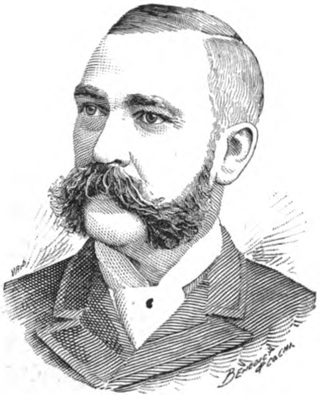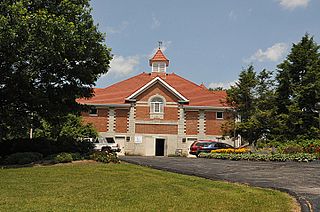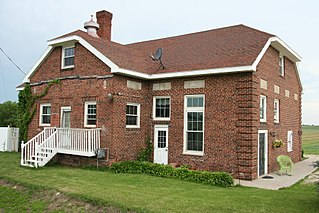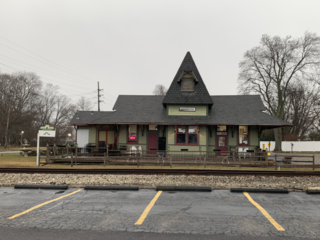
Barberton is a city in Summit County, Ohio, United States. The population was 25,191 at the 2020 census. Located directly southwest of Akron, it is a suburb of the Akron metropolitan area.

Ohio Columbus Barber was an American businessman, industrialist and philanthropist. He was called "America's Match King" because of his controlling interest in the Diamond Match Company, which had 85 percent of the market in 1881. He founded the city of Barberton, Ohio in 1891 and moved his manufacturing plant there in 1894. It produced 250 million matches per day. He also founded the Akron City Hospital.

Lake Anna Park is a 21-acre (85,000 m2) park around a spring-fed, 10-acre (40,000 m2) lake, and is located in the center of downtown Barberton, Ohio.

The Anna–Dean Farm is a historic farm in Barberton, Ohio, United States. It is listed on the National Register of Historic Places and is the site of several structures independently listed on the Register.

The John Scott Farm is a historic farmstead near the community of Shandon, Ohio, United States. Established in the nineteenth century and still in operation in the twenty-first, the farmstead has been named a historic site because of its traditionally built agricultural structures.

The Viola Creamery is a rural building on the National Register of Historic Places in Viola, Minnesota, United States. It was designed by architect Harold Crawford and in built in 1924.

The O. C. Barber Barn No. 1, built in 1909, is an historic farm building located on the Anna-Dean Farm in Barberton, Ohio. It was built by American businessman and industrialist Ohio Columbus Barber, the developer of both Barberton, which he envisioned as a planned industrial community, and the nearby 3,500-acre (14 km²) Anna-Dean Farm, which he envisioned as a prototype for modern agricultural enterprise. Barber was called America's Match King because of his controlling interest in the Diamond Match Company.

The O. C. Barber Colt Barn, built in 1912, is an historic farm building located on Austin Drive on the Anna-Dean Farm in Barberton, Ohio. It was built by American businessman and industrialist Ohio Columbus Barber, the developer of both Barberton, which he envisioned as a planned industrial community, and the nearby 3,500-acre (14 km2) Anna-Dean Farm, which he envisioned as a prototype for modern agricultural enterprise. Barber was called America's Match King because of his controlling interest in the Diamond Match Company.
The O. C. Barber Machine Barn, also called the Implement House. built in 1911, is an historic farm building located on Austin Drive on the Anna-Dean Farm in Barberton, Ohio. It was built by American businessman and industrialist Ohio Columbus Barber, the developer of both Barberton, which he envisioned as a planned industrial community, and the nearby 3,500-acre (14 km²) Anna-Dean Farm, which he envisioned as a prototype for modern agricultural enterprise. Barber was called America's Match King because of his controlling interest in the Diamond Match Company.

The O. C. Barber Piggery, built in 1912, is a historic farm building located at 248 Robinson Avenue on the Anna-Dean Farm in Barberton, Ohio. It was built by American businessman and industrialist Ohio Columbus Barber, the developer of both Barberton, which he envisioned as a planned industrial community, and the nearby 3,500-acre (14 km2) Anna-Dean Farm, which he envisioned as a prototype for modern agricultural enterprise. Barber was called America's Match King because of his controlling interest in the Diamond Match Company.

The Diamond Match Company has its roots in several nineteenth century companies.
Barber House, Barber Farm, or Barber Barn may refer to:

The Martin Marmon House is a historic house near the village of Zanesfield in Jefferson Township, Logan County, Ohio, United States. Built by pioneer settler Martin Marmon around the year 1820, it is one of the best remaining examples of Quaker architecture in the area.

The Milk Pail Restaurant, formerly known as the Country Tea Room, is a historic restaurant (tearoom) in unincorporated Dundee Township, Kane County, Illinois, United States. It was originally a farmhouse for Increase C. Bosworth, who operated the farm as a creamery. He sold it to Max McGraw in 1926, who converted into a teahouse restaurant. To meet the demands of the changing tastes of travelers in the 1930s, the teahouse was converted into a full restaurant, featuring game from McGraw's nearby game preserve. The main building was listed on the National Register of Historic Places in 1999.

Glendale Cemetery is a historic rural cemetery located in Akron, Ohio. It was added to the National Register of Historic Places in 2001.

The Lakeview Tithing Office, also known as the Bunnell Creamery, is a historic building located in Provo, Utah, United States. It is listed on the National Register of Historic Places.

Barberton was a train station along the Erie Railroad main line in the city of Barberton, Summit County, Ohio, United States. Located 612.8 miles (986.2 km) from Hoboken Terminal on the Kent Division of the main line, the station first saw service in 1890 while under the ownership of the New York, Pennsylvania and Ohio Railroad, a subsidiary of the Erie Railroad, to help bring people to the new community. Passenger service was terminated on August 1, 1965, with the cancellation of the Atlantic Express (eastbound) Pacific Express (westbound), and multi-day trains from Hoboken to Dearborn Station in Chicago, Illinois.

The Clarks Grove Cooperative Creamery is a historic creamery in Clarks Grove, Minnesota, United States. It was established in 1890 as one of the first cooperative creameries in Minnesota. The Clarks Grove Cooperative Creamery used new technology and a well-organized cooperative system. It became a model for the Minnesota dairy industry. Ten years later, there were more than 550 cooperative creameries in the state.

Arthur Oswin Austin was an American electrical engineer and inventor. He is most known as the inventor of the Austin transformer, used to supply power for lighting circuits on radio towers. He founded Austin Insulator Company and was one of the country's foremost experts in high-voltage insulators. His research included improvements to radio transmission equipment and the effects of lightning on aircraft.





















